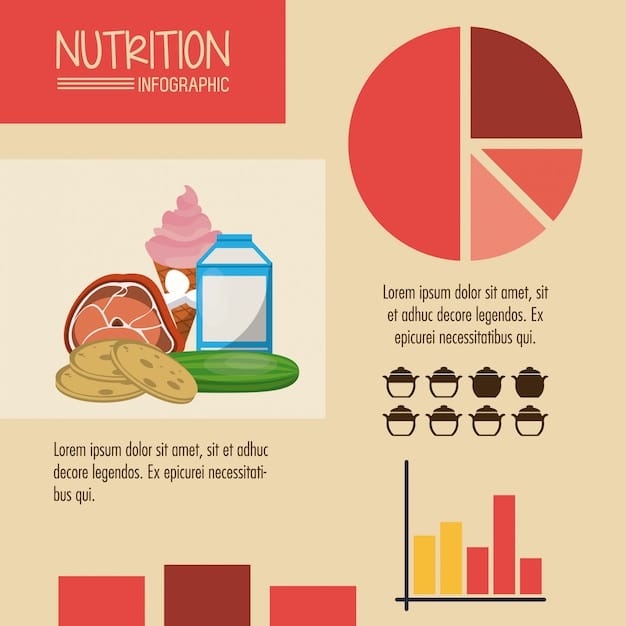2500 Calorie Bodybuilding Plan: 3 Adjustments for 2025 Gains

A 2500-calorie bodybuilding meal plan may stall gains if it lacks proper macronutrient distribution, micronutrient density, and dynamic adjustments for training intensity, necessitating strategic modifications for optimal muscle growth and recovery in 2025.
For bodybuilders, achieving consistent gains is a relentless pursuit, yet many find their progress plateaus despite rigorous training. A common culprit can be a seemingly adequate 2500 calorie bodybuilding meal plan stalling gains, failing to meet the body’s dynamic nutritional demands for muscle growth, repair, and energy, especially as training intensity evolves towards 2025.
Beyond the Numbers: The Nuance of Calorie Intake
While 2500 calories might seem like a solid foundation for muscle building, especially for individuals aiming for a modest surplus, the true effectiveness of any meal plan lies beyond the raw caloric number. A calorie is not merely a calorie; its source, macronutrient composition, and timing significantly influence its metabolic impact and utility for anabolic processes. Even a meticulously crafted 2500-calorie plan can become a bottleneck if it doesn’t align with the evolving physiological demands of intense resistance training.
Understanding the interplay between energy input and expenditure is critical. Athletes, particularly bodybuilders, have fluctuating energy needs based on training volume, intensity, and individual metabolic rates. What worked effectively during a bulking phase might become insufficient or maladaptive during a cutting cycle, or even as the body adapts to new training stimuli. This adaptability in diet is often overlooked, leading to frustrating plateaus.
The Problem with Static Plans
A static 2500-calorie plan assumes consistent energy demands and nutrient utilization, which is rarely the case in a dynamic sport like bodybuilding. Initial progress might be rapid as the body responds to new stimuli, but as the athlete gains muscle or increases training intensity, the caloric framework must adapt. Without these adjustments, the body’s energy reserves will dwindle, hindering recovery and preventing further adaptive responses.
- Training Adaptation: As muscles become stronger, they require more energy to perform the same work, and even more for progressive overload.
- Metabolic Rate Changes: Increased muscle mass leads to a higher resting metabolic rate, burning more calories even at rest.
- Recovery Demands: Intense training creates greater catabolic stress, requiring more nutrients for repair and regeneration.
Failure to recognize these shifts can lead to a caloric deficit that, while unintended, effectively puts the body in a state of under-recovery and impaired growth. This is particularly true for individuals with higher lean body mass or those engaging in very high-volume training sessions. The very plan designed to build can, paradoxically, inhibit progress if not re-evaluated regularly.
Conclusion: A fixed caloric intake might serve as a starting point, but its long-term viability for continuous gains in bodybuilding is severely limited by the body’s dynamic nature and adaptive responses to training.
Adjustment 1: Optimizing Macronutrient Ratios for Anabolism
The distribution of macronutrients—proteins, carbohydrates, and fats—within a 2500-calorie daily intake is far more impactful than the total calorie count alone. For a bodybuilder, this means ensuring an optimal supply of amino acids for muscle protein synthesis, sufficient carbohydrates for energy and glycogen replenishment, and healthy fats for hormonal balance and overall health. A common pitfall is either insufficient protein intake, inadequate carbohydrates to fuel intense workouts, or an imbalance of fat types.
Protein is the cornerstone of muscle building. While general guidelines exist, an active bodybuilder’s needs often lean towards the higher end of the spectrum. Consuming enough protein, specifically a complete amino acid profile, post-workout and throughout the day is critical for continuous muscle repair and growth. Without adequate protein, the body struggles to rebuild and strengthen muscle fibers damaged during training, regardless of total caloric intake.
Fine-Tuning Carbohydrate and Fat Allocation
Carbohydrates serve as the primary fuel source for high-intensity exercise and are essential for replenishing muscle glycogen stores. An insufficient intake can lead to fatigue, poor performance during workouts, and impaired recovery. The type of carbohydrates also matters; opting for complex carbohydrates provides sustained energy and avoids blood sugar spikes and crashes. Dietary fats, though often feared, are crucial for hormone production, nutrient absorption, and cellular function. Healthy fats, such as those found in avocados, nuts, and olive oil, contribute significantly to overall health and anabolic processes.
- Protein Priority: Aim for 0.8-1.2 grams of protein per pound of body weight to support muscle anabolism.
- Carbohydrate Timing: Distribute carbohydrate intake around workouts to maximize energy and recovery.
- Healthy Fats: Ensure 20-30% of total calories come from healthy fats for hormonal support and nutrient delivery.
For example, if your 2500 calories are heavily weighted towards fats with insufficient protein or carbohydrates, you might have energy, but lack the building blocks for muscle or the fuel for performance. Conversely, a diet too low in healthy fats can negatively impact hormone levels crucial for muscle growth. It’s about finding the right balance that supports both immediate training demands and long-term physiological needs.
Conclusion: Merely counting calories is insufficient; the allocation of those calories among proteins, carbohydrates, and fats—tailored to specific training phases and individual responses—is paramount for sustained bodybuilding gains.

Adjustment 2: Micronutrient Density and Food Quality
Beyond macronutrients, the quality of food sources and the density of micronutrients—vitamins and minerals—play a pivotal role in a bodybuilder’s ability to recover, adapt, and grow. A 2500-calorie plan filled with processed foods, refined sugars, and unhealthy fats might hit the caloric target, but it will inevitably fall short on the essential micronutrients needed for optimal physiological function. These include everything from energy metabolism to immune system support and bone health, all critical for high-performance athletes.
Micronutrients act as cofactors for countless enzymatic reactions within the body, many of which are directly involved in muscle repair, energy production, and hormonal regulation. For instance, B vitamins are crucial for energy metabolism, vitamin D for bone health and testosterone production, and magnesium for muscle contraction and relaxation. Deficiencies in any of these can subtly, but consistently, undermine training efforts and recovery, leading to stalled progress.
Prioritizing Whole, Unprocessed Foods
Shifting the focus towards whole, unprocessed foods ensures a higher intake of a broad spectrum of micronutrients and beneficial compounds. Lean proteins, complex carbohydrates like whole grains and root vegetables, and a variety of colorful fruits and vegetables provide not just calories, but a rich array of vitamins, minerals, and antioxidants. These components are vital for reducing oxidative stress from intense training, supporting immune function, and facilitating efficient nutrient utilization.
- Variety of Produce: Incorporate a wide range of fruits and vegetables for diverse micronutrient intake.
- Lean Protein Sources: Choose lean meats, fish, eggs, and legumes for complete protein and essential vitamins.
- Whole Grains: Opt for quinoa, brown rice, and oats over refined grains for fiber and B vitamins.
The concept here is nutrient partitioning: how efficiently the body uses the nutrients it receives. Even if calories are sufficient, a poor micronutrient profile can mean calories aren’t being metabolized efficiently, or recovery processes are impaired. This is where the difference between “eating enough” and “eating well” becomes starkly evident. A diet rich in nutrient-dense foods not only fuels performance but also fortifies the body’s foundational health, allowing for sustained, high-intensity training and optimal anabolism.
Conclusion: The quality of your 2500 calories, specifically their micronutrient density, is as important as the quantity. Prioritizing whole, unprocessed foods can unlock greater potential for gains by supporting vital bodily functions and enhancing overall health.
Adjustment 3: Dynamic Calorie and Macro Cycling
Perhaps the most sophisticated adjustment for a 2500-calorie bodybuilding meal plan is the implementation of dynamic calorie and macronutrient cycling. The human body is incredibly adaptive, and a consistent, unchanging caloric intake, even if seemingly adequate, can lead to metabolic adaptation where the body becomes highly efficient at operating on that specific energy level, slowing down progress. This adjustment acknowledges that energy demands fluctuate daily, weekly, and across different training phases.
Dynamic cycling involves strategic variations in caloric intake and macronutrient ratios to prevent metabolic plateaus, optimize performance on training days, and enhance recovery on rest days. On intense training days, a slightly higher caloric intake, often with increased carbohydrates, can provide the necessary fuel. On rest days or lighter training days, a slight reduction in calories, particularly from carbohydrates, can prevent excess fat accumulation while still supporting recovery.
Implementing Strategic Adjustments
This approach requires a deeper understanding of one’s own body and training schedule. It’s not about drastic swings, but calculated adjustments based on activity levels. For example, a heavy leg day might warrant an extra 200-300 calories, predominantly from carbohydrates, compared to a rest day where protein intake remains high but carbohydrates and fats are slightly reduced. This prevents the body from becoming too efficient at one caloric level and keeps metabolism responsive.

- High Training Days: Increase carbohydrates and total calories to fuel performance and recovery.
- Low Training/Rest Days: Slight reduction in calories, particularly carbohydrates, focusing on protein and healthy fats.
- Refeed Days (Occasional): Strategically higher carb days to replenish glycogen and boost leptin levels.
Furthermore, implementing occasional “refeed” days—where caloric intake, particularly from carbohydrates, is significantly increased—can provide psychological breaks and physiological benefits, such as replenishing muscle glycogen, boosting leptin levels (a hormone that regulates appetite and metabolism), and preventing metabolic deceleration. This strategic manipulation helps trick the body, preventing it from settling too comfortably into a fixed caloric intake and stalling progressive overload.
Conclusion: Moving from a static 2500-calorie plan to a dynamic, cycled approach accounts for the body’s adaptive nature, optimizing energy availability for performance and recovery while preventing metabolic plateaus, paving the way for consistent gains.
Advanced Considerations for 2025 Bodybuilding Nutrition
As bodybuilding science and practice evolve towards 2025, several advanced nutritional considerations complement the foundational adjustments to a 2500-calorie plan. These factors, while not replacing the core principles of macros, micros, and cycling, offer additional layers of optimization for those committed to maximizing their gains. They include the role of gut health, hydration, and strategic supplementation.
Gut health, for instance, is increasingly recognized as a cornerstone of overall health and athletic performance. A healthy gut microbiome ensures efficient nutrient absorption, robust immune function, and even influences mood and energy levels. Incorporating fermented foods (like yogurt, sauerkraut, kimchi) and prebiotic fibers (from foods like oats, bananas, onions) can foster a thriving gut environment, enabling the body to extract maximum benefit from the 2500 calories consumed.
Beyond the Plate: Hydration and Supplementation
Hydration is often underestimated but fundamentally impacts every metabolic process, from nutrient transport to thermoregulation. Even mild dehydration can impair performance, reduce strength, and slow recovery. For a bodybuilder, consistent and adequate fluid intake—not just water, but also considering electrolytes—is non-negotiable, particularly around training sessions. This ensures muscles function optimally and waste products are efficiently removed.
- Gut Health Focus: Integrate probiotics and prebiotics to enhance nutrient absorption and overall well-being.
- Strategic Hydration: Monitor fluid intake, especially during and around workouts, considering electrolyte balance.
- Evidence-Based Supplementation: Focus on supplements with proven efficacy like creatine, protein powder, and possibly BCAA’s or HMB to support specific goals, after foundational nutrition is solid.
Strategic supplementation, though not a substitute for a well-planned diet, can fill nutritional gaps and provide an edge. Creatine, for example, is well-researched for enhancing strength and power, while high-quality protein powders can help meet daily protein targets conveniently. However, the emphasis in 2025 remains on whole foods first, with supplements serving as targeted support, not primary components of the 2500-calorie plan.
Conclusion: True nutritional optimization for bodybuilding in 2025 extends beyond basic caloric and macronutrient counting, encompassing gut health, diligent hydration, and smart, evidence-based supplementation to unlock the full potential of a well-crafted diet.
Common Pitfalls and How to Avoid Them
Even with advanced knowledge, bodybuilders often fall into common traps that can derail their progress, even when adhering to a 2500-calorie plan. Recognizing and actively avoiding these pitfalls is just as crucial as implementing the right adjustments. These often relate to consistency, underreporting or overreporting intake, and succumbing to fads.
One major pitfall is inconsistency. A 2500-calorie plan only works if it’s consistently followed. Skipping meals, snacking impulsively without tracking, or significantly deviating from the plan on weekends can quickly negate the benefits of a well-structured diet. Bodybuilding success hinges on disciplined execution day in and day out.
Monitoring and Adapting: The Key to Progress
Another prevalent issue is inaccurate tracking. Many overestimate their calorie burn or underestimate their intake, leading to an unconscious caloric deficit or surplus. Using food scales, MyFitnessPal, or other precise tracking methods is essential, particularly when aiming for specific caloric and macronutrient targets. Similarly, relying solely on perceived hunger or fullness can be misleading, especially when the body is adapting to stress.
- Consistent Tracking: Meticulously log food intake and monitor progress to ensure accuracy.
- Avoiding Extremes: Steer clear of restrictive diets or fad supplements that promise quick fixes but lack scientific backing.
- Regular Re-evaluation: Periodically assess progress, body composition, and energy levels to make informed adjustments.
Finally, the allure of quick fixes and new fads often diverts attention from fundamental principles. While new research emerges, the core tenets of bodybuilding nutrition remain: adequate protein, appropriate carbohydrates and fats, nutrient density, and intelligent caloric management. Chasing every new supplement or dietary extreme can lead to suboptimal results and even health issues. A pragmatic, science-informed approach, coupled with consistent self-assessment, is the most reliable path to avoiding these common setbacks and ensuring your 2500-calorie plan truly supports your gains.
Conclusion: Avoiding common pitfalls like inconsistency, inaccurate tracking, and chasing fads is as critical as implementing strategic adjustments to a 2500-calorie plan. Discipline, precision, and a focus on fundamental, evidence-based nutrition are paramount for sustained bodybuilding progress.
Strategic Meal Planning for Targeted Gains
Translating theoretical adjustments into a practical 2500-calorie bodybuilding meal plan requires strategic meal planning. This isn’t just about combining foods; it’s about structuring meals to optimize nutrient timing, maximize satiety, and support recovery throughout the day. A well-planned schedule ensures consistent nutrient delivery, which is vital for continuous muscle protein synthesis and energy maintenance.
For instance, splitting 2500 calories into 4-6 smaller meals allows for more frequent protein feedings, which can be beneficial for maintaining an anabolic state. Each meal should ideally contain a balance of protein, complex carbohydrates, and healthy fats, tailoring portions to fit the overall caloric and macronutrient targets. Pre- and post-workout nutrition also warrants specific attention, ensuring immediate fuel for performance and rapid recovery nutrients.
Sample Meal Structure and Food Choices
A typical day might involve a high-protein breakfast with complex carbs, a mid-morning snack, a balanced lunch, a pre-workout fuel, a post-workout recovery meal, and a lighter, protein-rich dinner. The specific foods chosen should prioritize nutrient density and quality. For example, oatmeal with berries and protein powder for breakfast, chicken breast salads for lunch, and lean steak with sweet potatoes for dinner. Snacks could include Greek yogurt, nuts, or a piece of fruit.
- Breakfast: Oats (complex carbs), protein powder (protein), berries (micronutrients).
- Lunch: Lean protein (chicken/fish), mixed vegetables (micronutrients), quinoa/brown rice (complex carbs).
- Dinner: Red meat/lentils (protein/iron), sweet potatoes (complex carbs), green leafy vegetables (micronutrients).
The key is flexibility within structure. While a template is useful, personal preferences, dietary restrictions, and cooking availability must be considered. Batch cooking meals on weekends can significantly improve adherence during busy weekdays. Furthermore, periodically rotating food sources can prevent nutrient deficiencies and keep the diet interesting, which is crucial for long-term sustainability. This strategic approach to meal planning ensures that every calorie serves a purpose, directly contributing to your bodybuilding goals.
Conclusion: Strategic meal planning transforms a 2500-calorie target into a functional blueprint for consistent gains, emphasizing nutrient timing, food quality, and practical implementation to support rigorous training and recovery.
| Key Point | Brief Description |
|---|---|
| 📊 Macro Optimization | Adjust protein, carbs, fats for anabolism; more than just calorie counting. |
| 🍎 Micronutrient Density | Prioritize whole foods for critical vitamins and minerals supporting recovery and function. |
| 🔄 Dynamic Cycling | Vary calories/macros based on training intensity to prevent metabolic adaptation. |
| ⏱️ Strategic Meal Timing | Plan meals around workouts to optimize energy, recovery, and nutrient absorption. |
Frequently Asked Questions
▼
A 2500-calorie plan may stall if your body adapts, or if your training intensity increases beyond its capacity. It might also be due to improper macronutrient distribution, leading to insufficient fuel for workouts or inadequate building blocks for muscle repair. Metabolic changes as you gain muscle also increase your baseline caloric needs, making a once-sufficient intake now a deficit.
▼
Start by aiming for 0.8-1.2 grams of protein per pound of body weight. For carbohydrates, tailor intake based on activity; higher on training days, slightly lower on rest days. Fats should constitute 20-30% of your total calories, focusing on healthy sources. Use a tracking app to monitor and refine these ratios, observing how your body responds to different distributions.
▼
Micronutrient-dense foods include lean meats, fish, eggs, whole grains (quinoa, brown rice, oats), a wide variety of colorful fruits and vegetables (spinach, broccoli, berries, citrus), and healthy fats (avocado, nuts, seeds). These foods provide essential vitamins, minerals, and antioxidants crucial for performance, recovery, and overall health beyond just calories.
▼
Dynamic calorie cycling involves varying your daily caloric intake based on your training schedule. On intense training days, you might consume slightly more calories (especially carbohydrates) to fuel performance and recovery. On rest days or lighter training days, you’d slightly reduce calories to prevent excess fat gain and manage energy. This prevents metabolic adaptation and keeps your body responsive.
▼
Supplements should complement a well-structured whole-food diet, not replace it. Once your 2500-calorie plan is optimized for macros and micros, consider evidence-based supplements like creatine for strength, protein powder for meeting protein targets, and potentially a multivitamin if dietary intake is insufficient. Always prioritize whole-food nutrition as the foundation of your bodybuilding diet.
Conclusion
Ultimately, a 2500-calorie bodybuilding meal plan is merely a starting point, not a rigid endpoint, for achieving sustained gains. True progress in bodybuilding demands a nuanced, dynamic approach to nutrition that extends far beyond a simple caloric target. By meticulously optimizing macronutrient ratios, prioritizing micronutrient density from whole food sources, and embracing dynamic calorie and macro cycling, bodybuilders can transcend plateaus and unlock new levels of growth and performance. These adjustments, coupled with an understanding of individual needs and consistent tracking, transform a basic caloric intake into a powerful anabolic tool, setting the stage for significant achievements in 2025 and beyond.





